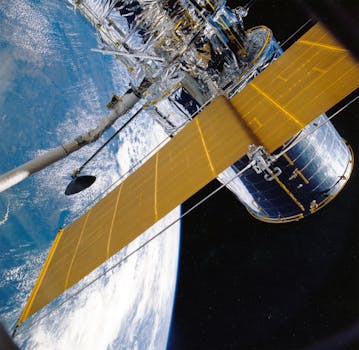
Beyond Earth: How Recent Advances Are Shaping Satellite Telecommunications
Satellite Telecommunications
Recent advances in satellite telecommunications are transforming the way we communicate beyond Earth’s orbit. The increasing demand for global connectivity, driven by the growth of industries such as aviation, maritime, and rural broadband, has spurred significant investments in space technology. As a result, satellite telecommunications have become more efficient, reliable, and accessible, enabling new applications and services that were previously unimaginable.
The development of advanced satellite constellations, such as OneWeb and Starlink, has been a major driver of innovation in the industry. These constellations comprise hundreds of small satellites in low Earth orbit (LEO), which provide high-speed, low-latency internet connectivity to remote and underserved areas. The use of LEO satellites has reduced the cost and increased the efficiency of satellite telecommunications, making it possible to connect millions of people around the world who were previously without access to the internet.
Another significant advancement in satellite telecommunications is the introduction of phased array antennas. These antennas use advanced beamforming technology to steer and shape the satellite’s signal, allowing for more efficient use of bandwidth and increased throughput. Phased array antennas have also enabled the development of satellite-based 5G networks, which promise to revolutionize the way we communicate on the go.
Advances in Space Technology
Recent advances in space technology have also played a crucial role in shaping the satellite telecommunications industry. The development of reusable launch vehicles, such as SpaceX’s Falcon 9, has significantly reduced the cost of launching satellites into orbit. This has made it possible for companies to launch larger constellations of satellites, which in turn has enabled the provision of more comprehensive and reliable satellite telecommunications services.
The use of advanced materials and manufacturing techniques has also improved the performance and lifespan of satellites. For example, the development of high-temperature superconducting materials has enabled the creation of more efficient and compact satellite components, such as antennas and transceivers. Additionally, the use of 3D printing and other advanced manufacturing techniques has reduced the production time and cost of satellite components, making it possible to launch more satellites into orbit.
Applications and Services
The recent advances in satellite telecommunications have enabled a wide range of new applications and services. One of the most significant is the provision of broadband internet access to remote and underserved areas. Satellite-based internet services, such as those offered by HughesNet and Exede Internet, have connected millions of people around the world who were previously without access to the internet.
Satellite telecommunications have also enabled the development of new services, such as satellite-based navigation and mapping. The use of satellite-based navigation systems, such as GPS and GLONASS, has become ubiquitous in modern transportation systems, from aviation and maritime to automotive and rail. Additionally, satellite-based mapping services, such as Google Earth and Google Maps, have revolutionized the way we navigate and understand our surroundings.
Conclusion
In conclusion, recent advances in satellite telecommunications are transforming the way we communicate beyond Earth’s orbit. The development of advanced satellite constellations, phased array antennas, and reusable launch vehicles has enabled the provision of more efficient, reliable, and accessible satellite telecommunications services. As the industry continues to evolve, we can expect to see even more innovative applications and services emerge, from satellite-based 5G networks to advanced navigation and mapping systems.





